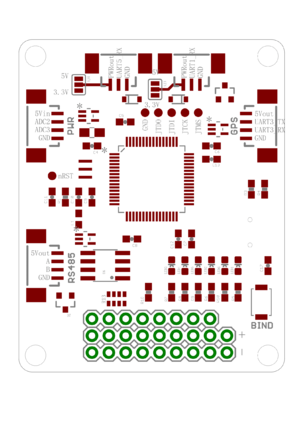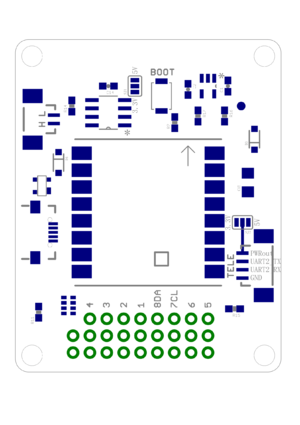Difference between revisions of "LisaLC"
(LisaLC) |
m |
||
| Line 2: | Line 2: | ||
=Features= | =Features= | ||
The main features are almost identical to Lisa MX, except the following are not available in | The main features are almost identical to Lisa MX, except the following are not available in LisaLC: | ||
#LisaLC is larger (40x50mm). | #LisaLC is larger (40x50mm). | ||
#PB1 instead of PB2 is used for bind button while the latter is always pulled down for entering DFU mode. | #PB1 instead of PB2 is used for bind button while the latter is always pulled down for entering DFU mode. | ||
| Line 9: | Line 9: | ||
#PC4 which is the default battery ADC port is not accessible. | #PC4 which is the default battery ADC port is not accessible. | ||
There are some | There are some new features in LisaLC: | ||
#A boot mode button is added to enter DFU mode. So that firmware can be uploaded via USB cable. No JTAG/SWD debugger is used. This feature is useful for field programming. | #A boot mode button is added to enter DFU mode. So that firmware can be uploaded via USB cable. No JTAG/SWD debugger is used. This feature is useful for field programming. | ||
Latest revision as of 08:26, 20 January 2016
LisaLC is a derivation of Lisa MX, the LC in its name means low cost. The controller consists of two double layer boards and 0603 or larger package to reduce cost of assembly.
Features
The main features are almost identical to Lisa MX, except the following are not available in LisaLC:
- LisaLC is larger (40x50mm).
- PB1 instead of PB2 is used for bind button while the latter is always pulled down for entering DFU mode.
- The dedicate SPI port is removed, and it’s only accessible via IMU port.(Which means there two SPI ports on IMU port)
- JTAG connector is replaced by several solder pad.
- PC4 which is the default battery ADC port is not accessible.
There are some new features in LisaLC:
- A boot mode button is added to enter DFU mode. So that firmware can be uploaded via USB cable. No JTAG/SWD debugger is used. This feature is useful for field programming.
- RS485 interface is added. However, currently there is no software support for it.
- [Not tested] ESD protection on UART, CAN, RS485, ADC, RC and USB port. EMI filters are also applied for ADC.
Main Board Specification
- Dimension: 40x50mm, with 4 M3 mounting holes.
- STM32F405RGT6 MCU with 192KB RAM and 1024KB flash.
- Three ADC port, two on power port and one on IMU port.
- Eight PWM output.
- One CAN bus port.
- One RS485 bus port.
- USB port for uploading firmware or telemetry with other onboard computer.
- Telemetry port with user selectable power voltage (5/3.3 V via solder jumper).
- GPS port.
- Two RC port for use with Spectrum, S.Bus and PPM receiver.
IMU Specification
- Dimension: 23x23mm.
- MPU6000 accelerometer / gyroscope.
- HMC5983 magnetometer.
- MS5611 barometer.
- TPS79301 ultra low noise LDO.
As the sensors used are QFN packages, it is very difficult to hand solder those chips, especially for the mag which is vulnerable to heat. It is recommended to build the board with a stencil and SMD reflow tools such as hot air gun or hot plate. The stencil file can be found in the gerber folder of IMU design files.
Pinout
The following ports are on the top side: power port, RC ports, PWM outputs, RS485 port and GPS port. CAN port and telemetry port are on the bottom side.
LEDs
The LEDs are same as those on Lisa MX, except the sequence is changed. From center to boarder:
LED_3, green
GPS_LED: blinking if trying to get a fix, on if 3D fix
LED_4, yellow
RADIO_CONTROL_LED: on if RC signal is ok
LED_5, red
Not set to anything by default
LED_2, orange
AHRS_ALIGNER_LED: blinks until the AHRS is aligned (gyro bias initialized) and then stays on
LED_6, green
Power indicator, always on when the board is powered.
LED_1, red
SYS_TIME_LED: blinks with 1Hz
Powering the Board
The ONLY correct way to power the board in vehicle is via power port. Although power via USB port by onboard computer is possible, it’s not recommended due to power limitation of USB port. The input voltage of power port is 5V. The LDO is capable of handling up to 16V input, but it’s *NOT* recommended to power directly via 3s or 4s Li-Po battery. The board should be powered via DC-DC converter with 5V output. There are two ADC inputs on power port which are designed to monitor battery voltage and current. Note that there are no voltage divider on those inputs, so external power dividers are needed. Refer to the power section of Lisa M wiki for how to setup voltage dividers.
RC Receivers
Please refer to corresponding section in Lisa M wiki. The only difference is that Lisa LC is capable of powering 5V receivers by selecting 5V output of SJ3 or SJ4.
PWM outputs
The PWM outputs are identical to Lisa MX. Refer to silk screen for Lisa MX channel numbers. The power pins of PWM port are connected with each other but disconnected from other part of the board. Therefore it's impossible to power the board by the BEC of an ESC. There is also an extra power connection on PWM port, which may be used to provide power when there are 8 servos to control.
CAN bus
One CAN bus is available for connecting various devices such as high performance ESCs or external sensors. The board is designed for use with both 3.3V and 5V CAN transceivers. For example, SN65HVD232D 3.3V or TJA1050 5V. This design is useful to reduce BOM costs as it enables choice of most cost effective devices. The transceiver and its supporting devices can be un-populated to further reduce costs if CAN bus is not needed. E.g. when using PWM based ESCs.
RS485 bus
One RS485 bus is available for connecting various devices like external IMUs. E.g. MTi 10-series IMU from Xsens. Note that currently there is no software for RS485.
GPS and telemetry port
Those two ports are same as Lisa MX, except that the telemetry port is capable of providing 3.3V or 5V power support for the modem. When using 3.3V, calculate power consumption of modem and make sure the current draw of modem together with Lisa LC does not exceed the max output current of LDO (which is 500mA).
Firmware upload
The firmware can be upload via JTAG/SWD debugger. Just solder some wires on the solder pads to access JTAG/SWD of the STM32 MCU.
While it’s possible and perfectly fine to upload via JTAG/SWD. It’s recommended to use STM32 MCU built-in DFU mode to upload new firmware, especially for in field programming. To enter DFU mode, disconnect the board from onboard power, press the BOOT button which is on the same side of IMU while connecting USB cable to computer. The board will then be powered by USB. Then set flash mode to dfu-util in PPZ-Center and flash! Refer to DFU page for details.
Design files
These files are available in git repo.
- EAGLE schematics and layout
- Gerber files
- Pick & place files
- BOM
- PDF version of schematics

